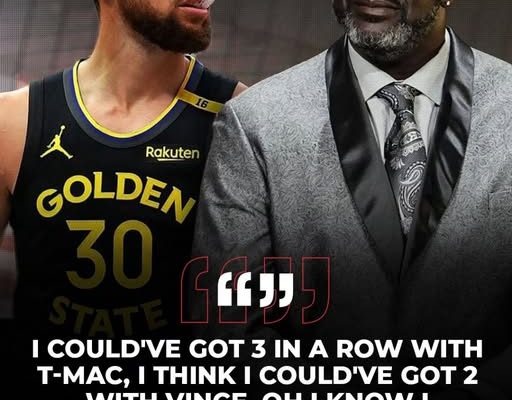Shaquille O’Neal, one of the most dominant forces the NBA has ever seen, has never been shy about offering bold opinions on basketball’s past, present, or future. But his latest statement has ignited a firestorm across the sports world. During a recent interview, Shaq claimed that if he had played alongside Steph Curry, the two would have won six straight NBA championships. That’s not a throwaway comment—it’s a thunderous declaration from a four-time champion who knows what it takes to win at the highest level. The idea of merging Shaq’s overwhelming power with Steph’s long-range brilliance is the kind of fantasy pairing that basketball fans can only dream about, but it’s worth breaking down what makes this hypothetical duo so compelling—and perhaps even plausible.
First, it’s important to understand who Shaq was in his prime. Listed at 7-foot-1 and around 325 pounds, he wasn’t just big—he was agile, explosive, and unrelenting in the paint. During his peak years with the Los Angeles Lakers from 1999 to 2002, he averaged nearly 29 points, 13 rebounds, and 3 blocks per game. He was virtually unguardable one-on-one and often required double or even triple teams to slow him down. His dominance in the low post forced defenses to collapse, which opened up shots for perimeter players. The combination of brute strength and scoring touch was unmatched, and his presence alone could dictate the entire tempo of a game.
Now, imagine placing Steph Curry in that mix. Curry, the greatest shooter the game has ever seen, has revolutionized basketball with his limitless range, off-ball movement, and uncanny ability to stretch defenses. He’s not just a scorer—he’s a gravitational force on the floor. Defenders are so concerned with him that they change their entire strategy just to contain his shooting. What he lacks in physical stature he makes up for in basketball IQ, court vision, and shot-making wizardry. During his MVP seasons, Curry averaged over 30 points per game while maintaining elite efficiency. His presence alone can open up driving lanes and space the floor like no one before him.
Put these two together and you’ve got a nearly unstoppable offensive machine. Shaq operating out of the post with Curry running off screens would force defenses into impossible choices. If you double Shaq, Curry is wide open for a three. If you try to switch, Shaq punishes smaller defenders inside. If you hedge out on Curry, Shaq slips into the paint with a lob-ready position. The synergy between inside dominance and perimeter precision would likely redefine basketball efficiency.
From a tactical perspective, this hypothetical pairing also addresses each player’s historic weaknesses. Shaq, for all his dominance, was not a good free-throw shooter, and late-game fouling strategies (Hack-a-Shaq) often stalled momentum. But playing with someone like Curry, who is a career 90% free-throw shooter, would allow teams to avoid running everything through Shaq in clutch situations. Curry, on the other hand, has at times struggled against highly physical defenses, particularly in the playoffs. Enter Shaq, who would absorb physical contact in the paint and allow Curry more freedom to operate on the perimeter.
Then there’s the question of pace and space. Modern basketball emphasizes spacing and three-point shooting, while Shaq’s era was centered around post-play and half-court sets. Yet, in today’s NBA, big men who can’t shoot are often viewed as liabilities. But Shaq wasn’t just any big man—he was the most dominant interior scorer in league history. In a Curry-led offense, Shaq wouldn’t need to shoot from deep. Instead, he would feast in the paint while defenses tried to figure out how to cover the arc. Imagine a lineup where defenders are stretched to the limit by Curry and forced to protect the rim against Shaq—it’s a no-win situation for the opposition.
Critics may argue that their styles might clash. Curry thrives in a free-flowing, high-tempo offense, while Shaq excelled in structured, grind-it-out half-court sets. But that overlooks the adaptability both players have shown throughout their careers. Shaq played with guards of all kinds—Penny Hardaway, Kobe Bryant, Dwyane Wade—and adjusted his role accordingly. Curry has played alongside ball-dominant stars like Kevin Durant and still managed to maintain his impact without disrupting chemistry. If anything, both players are basketball savants who elevate teammates and understand how to defer when needed.
The real intrigue lies in imagining the coaching dynamics. Who could bring out the best in both players? Phil Jackson famously harnessed Shaq and Kobe’s talents using the triangle offense. Steve Kerr unlocked the modern Golden State system that turned Curry into a two-time MVP. Perhaps a hybrid system—employing motion offense principles with strategic post-ups—would suit this super duo best. The offense could initiate through Curry’s movement and end with Shaq’s physicality, or vice versa. Both would require touches, but neither has historically demanded to dominate the ball for the full 48 minutes.
Team-building around them would be easier than one might think. Role players would need to be three-and-D wings, capable of spacing the floor and defending multiple positions. Think players like Klay Thompson, Robert Horry, or Andre Iguodala—guys who don’t need the ball in their hands but make an impact nonetheless. With Curry and Shaq as the focal points, the rest of the roster could be filled with defenders, shooters, and utility players. Rebounding would be no issue with Shaq anchoring the paint, and transition offense would be electric with Curry leading the break.
Could they really win six straight titles? That’s a lofty claim, even for Shaq. Only the 1960s Celtics have accomplished a six-peat, and that came in a very different era. Even Michael Jordan’s Bulls capped out at three-peats twice. Injuries, egos, roster turnover, and rising competition often prevent dynasties from lasting that long. But talent-wise, few duos in history would compare to Shaq and Curry. They possess complementary skill sets that would torture defenses in ways we haven’t yet seen. Given the right organizational stability and health, winning six in a row isn’t out of the realm of possibility—it’s just exceedingly rare.
The mental component also deserves attention. Shaq was notoriously confident, sometimes bordering on cocky, but he was also a proven winner who elevated his play in the postseason. Curry, though sometimes overlooked in all-time great debates, has proven time and again that he’s capable of taking over games when it matters. Both have that killer instinct—expressed in different ways—but equally potent. Their leadership styles might differ, but the drive to win would align. More importantly, both have shown the ability to put egos aside for the sake of team success. Shaq did it with Wade in Miami; Curry did it with Durant in Golden State.
Social media lit up with reactions to Shaq’s bold statement. Some fans rolled their eyes at the fantasy pairing, accusing Shaq of living in a dream world. Others were quick to agree, imagining a dynasty unlike anything we’ve seen before. Analysts debated matchups, timelines, and team contexts, but one thing is certain: when two legends of the game inspire this kind of conversation, it’s because their greatness is undeniable. This is less about hypothetical titles and more about appreciating what each of them represents—dominance in two very different forms.
At the end of the day, we’ll never know for sure what a Shaq-Curry partnership would’ve looked like, but it’s a tantalizing thought experiment. It speaks to the magic of sports—the what-ifs, the alternate realities, the fusion of eras. Shaq’s comment wasn’t just bravado; it was a celebration of basketball’s evolution. From the bruising low post of the 90s to the three-point revolution of the 2010s, the idea of combining the best of both worlds offers a glimpse into a team that might have gone down as the greatest ever assembled.
Maybe they wouldn’t have won six straight. Maybe they would’ve won more. But one thing’s for sure—nobody would want to face them in a seven-game series.



